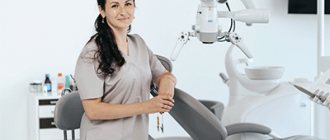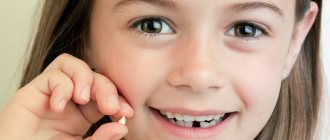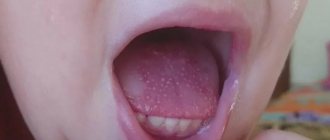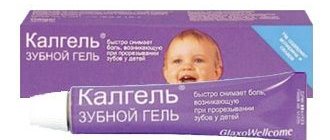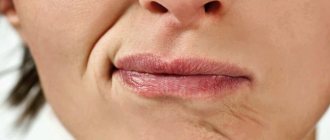A cracked lip in the middle not only spoils the appearance, but also causes pain. You will learn how dangerous the symptom is from the article.
The structure of the skin of our lips is very thin, delicate and sensitive. It is susceptible to negative influences: wind, heat, cold, etc.
If you do not properly care for your lips, you may feel chapped, uncomfortable, and your lips may peel and crack. To avoid this, you need to know and follow a few simple rules.
Why is my lip cracked in the middle?
- Manifestation of vitamin deficiency. A lack of vitamins belonging to groups A, B, E leads to impaired elasticity of the skin on the lips, as a result of which cracks may appear. In turn, vitamin deficiency can be caused by problems with the intestines and endocrine system, which leads to metabolic disorders or disruptions in the immune system. Hence, even a slight damage to the lip can cause cracks.
- A bad habit like smoking dries out your lips. Frequent licking, a strict diet, or snacking on the street can lead to the same result. The skin of the lips becomes dry, tightens, and the appearance of cracks is a natural result.
- The lip can crack as a result of using low-quality cosmetics or those that have expired. It is also possible to develop an allergy to decorative cosmetics, which can also cause cracks.
- Tooth decay is one of the reasons why lips become chapped. Bacteria that multiply in a diseased tooth spread to the lips, and if microtrauma appears on them, they are quite capable of increasing the negative effect. The same applies to fungal diseases.
- The mucous membranes and their condition depend on how the endocrine system works. Therefore, the presence of diabetes is also one of the reasons for the appearance of cracks on the lips. And a frequent desire to drink dries out your lips. To combat cracks in this case, it is recommended to take special medications.
- If a person has an incorrect bite , there may be accumulation of saliva in the corners of the lips, and consequently, their excessive moisture. If a crack appears on the lower lip, it is possible that the body is too polluted and it is necessary to undergo an examination of the gastrointestinal tract.
- Adverse weather conditions, prolonged exposure to the open sun or exposure to cold winds, sudden temperature changes. Cracked lip in the middle As a result of chapping and overdrying, dehydration occurs, both general and directly to the mucous membrane of the lips.
Due to external conditions - Unfavorable microflora , the presence of bacteria on the lips that destroy the structure of the skin, as a result of weakened immunity. The level of immunity decreases, in addition to the above reasons, also due to overwork, chronic lack of sleep, hypothermia, etc.
- Chemicals found in many food additives. Elementary common salt can “eat away” the skin of the lips to the point of ulcers, not to mention cracks.
- The influence of allergens of various origins, to which the skin of the lips often reacts negatively.
- Any mechanical impact . A bitten lip, an accidental prick from a fork, a cut - any damage to the lip can lead to a crack.
From exposure
Heilit (Zaeda)
Exfoliative cheilitis
It is a disease of the red border of the lips.
It is diagnosed mainly in women and is clinically manifested by peeling of the lips. The pathogenesis of exfoliative cheilitis includes neurological disorders - excitement, anxiety, depression. There is also a connection between the incidence of exfoliative cheilitis and hyperfunction of the thyroid gland. It has been proven that once it occurs, exfoliative cheilitis is inherited as a change in the immune system. Peeling is present only on the red border of the lips and does not spread to the mucous membrane and skin. The disease rarely spreads to the entire red border, so part of the red border in the area of the corners of the mouth and in areas bordering the skin remains free from peeling. If exfoliative cheilitis occurs against the background of dry skin, then in addition to peeling, patients note dry lips, burning, and sometimes the appearance of scales that are bitten or peeled off by hands. Exfoliative cheilitis has a long, sluggish course, with periods of remissions and exacerbations; not prone to self-healing.
During the examination, dry lips are revealed, the presence of scales tightly fused with the red border, due to which the edges of the red border look raised. Removal of the scales is usually painless; after their removal, a bright red surface without erosion is exposed. 5-7 days after removal, the scales appear again, fresh scales look like mica, and later they also adhere to the red border of the lips. With the exudative form of cheilitis, patients complain of soreness and swelling of the lips; Over time, large crusts appear, making speech and eating difficult.
Glandular cheilitis
The pathogenesis of glandular cheilitis involves congenital or acquired proliferation of the minor salivary glands, which contributes to their infection. In people with congenital anomalies of the minor salivary glands, symptoms of glandular cheilitis are observed in almost all cases. Patients with chronic periodontal diseases, tartar, and dental caries are at risk, since these diseases contribute to infection of the dilated ducts of the salivary glands.
Glandular cheilitis occurs both due to infection of the ducts of the salivary glands, and due to intoxication with toxins and waste products of microorganisms. Persons of both sexes suffer mainly after 30 years of age, while lesions of the lower lip are twice as common.
In the initial period of the disease, patients note slight dryness of the lips, which is compensated by lip care products and cracks that appear against the background of dryness. Subsequently, deep bleeding cracks and painful erosions form. Patients with grandular cheilitis tend to lick their lips, which further aggravates the symptoms of dryness, sometimes this leads to the appearance of weeping cracks against the background of dry and flaky skin of the lips. Later, the cracks are permanent due to impaired elasticity of the skin of the lips.
Contact allergic cheilitis
Occurs in response to exposure to a stimulus. The main causes of allergic cheilitis are substances that are part of lipsticks and lip care products. Allergic cheilitis can develop as a result of the bad habit of keeping foreign objects in the mouth: pens, pencils. Occupational allergic cheilitis develops in musicians in response to prolonged exposure to mouthpieces of wind instruments in the mouth.
Patients complain of severe itching, burning, swelling and redness of the lips. Moreover, after contact with an allergen, the symptoms of cheilitis are more pronounced. Sometimes the bubbles can be larger in size and after they are opened, cracks and erosions are exposed. When allergic contact cheilitis is chronic, the main clinical manifestations are peeling and slight itching without an inflammatory reaction.
Meteorological (actinic) cheilitis
It is part of a group of diseases whose pathogenesis involves hypersensitivity to cold, wind, solar radiation and radiation. Actinic cheilitis is more often diagnosed in men aged 20 to 60 years and often occurs in response to ultraviolet radiation. The survey determines general weather sensitivity, in particular sensitivity to solar radiation.
With the exudative form of cheilitis, patients complain of itching and burning of the lips, as well as the appearance of erosions and crusts. Sometimes, with meteorological cheilitis, small bubbles appear, after opening which painful erosions are exposed, which then dry out into crusts.
In the dry form of meteorological cheilitis, the main complaints are dryness and burning of the lips, and sometimes pain. In the case of a long course of actinic cheilitis, malignancy is possible; in the presence of factors such as smoking and dusty conditions in the room, the likelihood of malignancy increases. Often actinic cheilitis over time degenerates into precancerous diseases - limited hyperkeratosis, abrasive precancrosis cheilitis Manganotti, etc.
Atopic cheilitis
It is one of the manifestations of atopic dermatitis or neurodermatitis. An important pathogenetic link in atopic cheilitis is an allergic predisposition. In this case, allergens can be drugs, cosmetics, products, microorganisms and their toxins.
Patients with atopic cheilitis complain of redness of the lips, which is accompanied by itching and flaking of the red border of the lips, characteristically affecting the corners of the mouth. After the acute process subsides and during remissions, peeling and lichenification are noted. Constant dryness and infiltration of the corners of the mouth contributes to the appearance of cracks. Patients with atopic cheilitis have clinical manifestations of atopic dermatitis, neurodermatitis, dryness and flaking of the facial skin.
Macrocheilitis
Macrocheilitis is part of the Melkerson-Rossolimo-Rosenthal syndrome; the other components of the triad are facial neuritis and the folded tongue symptom. In the pathogenesis of this symptom complex, the infectious-allergic factor and hereditary predisposition are of great importance.
Patients complain of enlargement and itching of the lips, sometimes the swelling spreads to other parts of the face. Swelling with this type of cheilitis lasts indefinitely, sometimes a spontaneous improvement in well-being is possible, but after this a relapse occurs. The color of the lips and skin is not changed, although in places of swelling the skin is shiny and has a bluish-pink tint.
Usually one or both lips, cheeks, eyelids and other parts of the face in the area of innervation of the facial nerve are affected. In this case, neuritis of the facial nerve manifests itself in the form of a skewing of the face in the healthy direction, and the nasolabial fold is smoothed out. Because all three symptoms of the triad are not always present, diagnosing Melkersson–Rosenthal syndrome can be difficult.
Hypovitaminous cheilitis
It develops with a lack of B vitamins, with a particularly pronounced lack of vitamin B2. Patients complain of burning and dryness of the mucous membranes of the mouth, tongue and lips. During the examination, it is clear that the mucous membrane is slightly swollen, reddened, and on the red border of the lips there is fine scaly peeling and small vertical cracks against the background of dry and reddened skin of the lips. Cracks with hypovitaminous cheilitis are prone to bleeding and pain. Often, simultaneously with the development of cheilitis, changes are also observed in the tongue - it increases in size, and teeth marks become noticeable on it.
How to treat a cracked lip in the middle: therapeutic agents
- If the lip is cracked in the middle as a result of a fungal disease, you should use appropriate antibacterial medications.
- This could be Tetracycline or methyluracil group, Levomekol, Vishnevsky balm.
- If there is no positive effect for a long time, you can try Purelan-100 , based on lanolin.
- Before using the drug, you should disinfect the damaged area and do not remove drying crusts on the lip.
- You can also use cream or Vaseline to soften and moisturize , lubricating the skin around the crack without touching it directly.
We soften
- This procedure must be repeated several times a day. Alternatively, you can replace Vaseline with pork fat.
My lip is cracked in the middle: what should I apply?
What to apply if your lip is cracked in the middle:
- Zinc ointment has an analgesic and disinfecting effect, relieves inflammation. From 3 to 5 times a day - and the wound will begin to heal. One “but”, check before using it to see if you have an allergic reaction or suppuration in the wound.
- Solcoseryl requires moisturizing after application. It has an analgesic effect and promotes rapid healing of the crack. Also monitor for any allergic reaction.
- Synthomycin . Quite an effective remedy with an antiseptic and analgesic effect. Due to many contraindications, it is better not to use this remedy without consulting a doctor.
- Bepanten . Recommended also for children, it has an anti-inflammatory effect, regenerates soft tissues.
Smear
Causes of dry and cracked lips
Adverse weather conditions
The skin of the lips is delicate and sensitive. Its stratum corneum is very thin, because there are no sweat glands (there are ducts of the sebaceous glands only in the corners). Because of this, the skin of the lips easily suffers due to the negative effects of aggressive external factors: wind, frost, temperature changes, dry air, solar radiation. As a result, it becomes weathered and begins to peel off, microcracks appear, which, in turn, can become an entrance “gate” for infection.
The air is too dry
This is especially true during the cold season. Heating appliances literally dry out the air in the room, which cannot but affect the condition of the skin, including lips.
Frequent lip licking
We often lick our lips automatically without noticing it. However, such moisture does not bring any benefit, but only promotes cracking. Enzymes contained in saliva can cause irritation to the sensitive and delicate skin of the lips. Moreover, the effect of such hydration lasts only a very short time. As saliva evaporates, it makes the skin of your lips even drier. The bad habit of frequently licking your lips can even cause inflammation over time.
Vitamin and mineral deficiency
A lack of vitamins in the body, in particular E and group B, can also lead to excessive fragility and dryness of the skin of the lips and the appearance of cracks. Moreover, both deficiency and excess of vitamin A can lead to cracking.
Often, cracked lips are one of the possible signs of iron deficiency in the body (it is necessary for transporting oxygen to cells). Due to the lack of this microelement, metabolic processes may be disrupted, which leads to the skin becoming dry.
Dehydration
Due to lack of moisture, the skin of the lips suffers first of all, because it does not have sebaceous glands. In any case, our skin needs hydration not only from the outside, but also from the inside.
Allergy
It can be triggered by components contained in lipstick and cosmetic care products, especially those of dubious quality.
Smoking
It not only gives an earthy tint to the skin of the face, kills the natural whiteness of teeth, but also contributes to cracking of the skin of the lips. Those who smoke produce less saliva, and the toxic tars contained in tobacco smoke reduce the formation of an enzyme such as lysozyme, which has a disinfecting effect. Because of this, the natural protection of the oral cavity is disrupted, and the healing processes of wounds and cracks slow down.
Mouth breathing
The cause of this can be either a simple runny nose or more serious health problems. In any case, when breathing through the mouth with exhalation, the lips are exposed to warm and dry air, and when inhaling, they are exposed to cold and moist air. As a result, the skin dries, peels and cracks.
Chronic diseases
Chronic diseases often cause dryness and cracks in the skin of the lips. These may be problems with the gastrointestinal tract, endocrine pathologies, as well as the herpes virus or stomatitis.
How to treat a cracked lip in the middle: folk remedies
Cracked lip in the middle:
- You need to lubricate the crack with honey . Its softening and bactericidal effect has a beneficial effect on healing. This method is good if you are not allergic to the product.
- Use sour cream and olive oil , adding a couple of drops. Make a mask from this composition and leave it overnight. You can lubricate your lips with butter, and before going out - with Vaseline. By the way, you can prepare your own lip mask from these ingredients, taking three parts oil to one part Vaseline.
- tea tree ether is quite effective . If you add 2-3 drops to almond or peach oil and apply to the wound, healing occurs within a few days. If not, it means that the inflammatory process is developing, and then medical consultation is necessary.
- Mix vegetable oil with kiwi fruit pulp and apply this mixture to your lip for 20 minutes. Rinse off the mixture and dry your lips, and then moisturize them with a special product. If it doesn’t help, use a compress containing vitamins A and E.
- If a small child, especially an infant, has a cracked lip, the reason is most likely due to the composition of the mother’s milk. Therefore, mother should enrich her diet with vitamins. You can lubricate with cream, the main thing is that they do not contain fragrances or dyes.
- Home doctor - aloe flower is a universal healing remedy, including for lip cracks.
- Another universal remedy - tea rose petals, which are recommended even for infants with stomatitis. Soaked in warm milk for half an hour and ground to a homogeneous consistency, they heal cracks well when applied to the lips.
Petals - Echination tincture , and not necessarily from a pharmacy, but also from our own production. Just fill a third of a liter jar with crushed dry echinacea and add alcohol, vodka, moonshine - any strong composition. Leave it to brew for a couple of weeks and take it to boost your immunity before going to bed.
Traditional Treatments
First, let's look at the traditional methods recommended by dermatologists.
- Ointments containing calendula oil. This plant heals inflammation in the corners of the lips (so-called jams) and soothes irritation in inflamed areas.
- Products based on lanolin. Preparations in which lanolin acts in combination with beneficial sea buckthorn oil are especially effective.
- A course of vitamins. If your body does not have enough vitamin E, it is better to start taking it in combination with vitamin A (in pairs, the body absorbs them better). You can also take a series of multivitamins - during the cold season, this will not only help the skin heal, but also generally strengthen the immune system.
A child’s lip is cracked in the middle: what to do?
- What to do if a child’s lip is cracked in the middle? Among the remedies used to treat cracked lips in children, mothers recommend the same Bepanten , as well as Boroplus in the form of a cream. The only disadvantage of the latter remedy is the strong sandalwood smell, which not all children like.
- The methods described above using honey and Vaseline are also used for children. They can be used to lubricate your child's lips while sleeping.
The child has
Before going outside, you need to apply a special hygiene lipstick for children to your baby’s lips. All products must be tested to ensure there are no allergies to them.
If the crack does not heal for a long time, you need to make sure that the child drinks enough fluids and eats foods containing vitamin A. In addition, it is necessary to control that the air in the room where the child is is not too dry.
Folk recipes
In addition to traditional methods, there are many folk remedies for treating cracked lips.
- Natural honey. It acts as an antiseptic and soothes painful wounds. Unlike traditional medicines, honey has no restrictions on its use - you can lubricate your lips with natural sweetness at least every hour.
- Natural aloe juice. It is recommended to apply freshly cut aloe leaf to cracks for several days in the morning and evening.
- Butter or rendered animal fat. You can find effective remedies in your refrigerator and lubricate your lips with oil.
How to prevent your lip from cracking in the middle?
- Make it a rule before you go outside to lubricate the skin of your lips with special protective products (lipstick, balm, etc.) - this way you will moisturize your lips and protect them from drying out. Periodically apply vegetable oils or propolis to your lips.
Lubricate
- Don’t forget about vitamins : natural, found in seasonal vegetables and fruits, and as part of vitamin complexes purchased in pharmacies.
- Apply masks before bed, which, once absorbed, will prevent cracking on frosty days.
- Smoking really dries out your lips, especially if it happens outdoors, combined with exposure to wind or sunlight. Alcohol does not have a better effect on the skin of the lips .
- Poor quality or expired cosmetics can cause great harm. And you shouldn’t borrow lipstick from a friend - this is a purely individual product, like a toothbrush or comb.
Maybe from low-quality cosmetics
- If you notice that your lip is cracked in the middle , this happens often, and it takes a long time to heal - consult a specialist and strictly follow the procedures recommended by him.
Cracked lip in the middle: does it need to be treated?
- Such microtrauma does not seem worth close attention to us, so many people ask the question: is the lip cracked in the middle - does it need to be treated?
- The answer to this question can be either positive or negative, depending on many circumstances.
- So, if a crack in your lip appears once and quickly heals on its own, and you do not feel any particular discomfort when eating, talking, or facial movements, you should wait a day or two without resorting to medications.
- If cracks begin to appear frequently , even if they heal quickly, it is best to consult a specialist, because it is possible that the problem indicates a malfunction in the body.
Should I treat the crack?
- By eliminating the initial cause determined by the doctor, you will also get rid of the appearance of cracks on your lips without additional effort.
- Well, and, of course, deep wounds that do not heal for a long time must be treated, again, having previously examined your body to see if everything is okay with it and whether there are any malfunctions in the functioning of any organ.
Reasons for appearance
Before you begin treating cracked lips, you need to understand the reasons that lead to them. It's no secret that lips most often begin to crack during the cold season, and there are several explanations for this.
- Vitamin deficiency in the body. In winter, many people stop eating fresh vegetables and fruits. Lack of vitamins B, B2, E leads to the fact that the skin of the lips loses its elasticity. This is why sometimes already weakened lips suddenly crack in the middle when we actively articulate or smile.
- The bad habit of licking your lips in the cold. The entry of saliva removes the thin protective layer from the delicate skin of the mouth, and allows frost and wind to dehydrate the surface of the lips.
- A sharp temperature change when leaving a heated room into cold air.
- The atmosphere of our warm apartments - the heat of the radiators “takes” moisture from the air and additionally dehydrates the lips.
Another possible explanation for the appearance of cracked lips, according to psychologists, is constant tension, dissatisfaction with oneself and depression. These negative emotional factors can cause lip skin irritation.
If you do nothing about the irritation that appears, you can get a chronic problem - the edges of the crack on the lip will become denser, and it will no longer heal on its own. If you can't figure out why your lips are chapped until they bleed, the explanation is most likely just such a chronic crack. Gradually increasing and deepening, the irritation touches small vessels on the surface of the lips, and this causes bleeding. Open wounds can easily become infected, so you need to start treating your lips as early as possible.
Cracked lip in the middle: a sign
Signs about what a crack on the lip means developed in ancient times and have survived to this day.
- Is your lip cracked in the middle? A sign of recent passionate kisses . This is explained by the fact that girls have long applied honey or wax coating to their lips to protect them from wind or sunlight. Before the date, this layer was washed off so that the lips were soft and natural. Deprived of their usual protection, and even under the influence of a hot kiss, their lips easily cracked, thereby betraying the secrets of the girl’s heart.
- Evil eye . Everyone has long known that a person who has been “jinxed” becomes vulnerable to negative influences. And all these factors negatively affect health, including skin condition. Therefore, it has become a custom to interpret the appearance of a crack on the lip as one of the signs that a person has been exposed to the evil eye.
- There is another interesting sign that warns you about what needs to be done to prevent your lips from cracking. You just need to kiss the ground at the first spring thunder . The sign says that this action will protect your lips from cracking (and, by the way, from toothache) for a whole year.
- There is also an interpretation of a dream in which you saw a crack in your lip. Such a dream speaks of impending troubles: failures, separations, unnecessary spending.
Herbal and natural active ingredients to treat dry and chapped lips
Lips are an important element for facial beauty, participating in verbal and visual communication, as well as food consumption. However, the skin of the lips is 5 times thinner than the skin of the body, so they need to be given special attention.
The lethal weapon against chapped lips and optimal hydration throughout the day is lipstick! Make it a rule to use paraben-free and paraffin oil-free lipstick because when there is too much of it, the skin rejects it, which increases dryness. Long-lasting shiny, matte or very dark lipsticks can prevent your lips from breathing.
Lip balm can also provide a layer of protection against the adverse effects of wind and cold. It can be used with confidence even when we are staying at home to lock in moisture inside the lips, while providing additional hydration due to the active ingredients it contains (especially if the balm is of good quality and contains essential oils).
Lip balm not only prevents dehydration, but also closes cracks on the lips, thereby preventing them from becoming infected.
Be careful, as many products found in lipsticks and lip balms can cause dehydration and aggravate irritation. This is the case with:
- Aluminum salts, menthol, eucalyptus, phenol and camphor. Menthol, camphor and phenols only cause a state of imaginary comfort, and sometimes even increase dehydration.
- Silicone oil is another very common ingredient (it's also found in lipsticks and glosses for added longevity), but it only promotes dehydration.
- Salicylic acid (although it has proven anti-inflammatory properties) in balms can promote dry lips and flaking.
- If you have acne-prone skin, it is best to avoid cosmetics containing petroleum jelly. Although this substance is very effective for dry lips, some users with acne-prone skin claim that these products can clog pores too much and contribute to the appearance of blackheads.
No less interesting article: Will a medical face mask help against flu and coronavirus infection?
Powered by Inline
